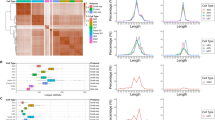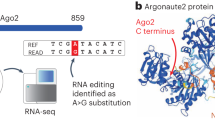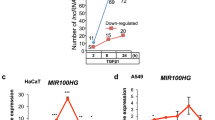Abstract
Transfection of small RNAs (such as small interfering RNAs (siRNAs) and microRNAs (miRNAs)) into cells typically lowers expression of many genes. Unexpectedly, increased expression of genes also occurs. We investigated whether this upregulation results from a saturation effect—that is, competition among the transfected small RNAs and the endogenous pool of miRNAs for the intracellular machinery that processes small RNAs. To test this hypothesis, we analyzed genome-wide transcript responses from 151 published transfection experiments in seven different human cell types. We show that targets of endogenous miRNAs are expressed at significantly higher levels after transfection, consistent with impaired effectiveness of endogenous miRNA repression. This effect exhibited concentration and temporal dependence. Notably, the profile of endogenous miRNAs can be largely inferred by correlating miRNA sites with gene expression changes after transfections. The competition and saturation effects have practical implications for miRNA target prediction, the design of siRNA and short hairpin RNA (shRNA) genomic screens and siRNA therapeutics.
This is a preview of subscription content, access via your institution
Access options
Subscribe to this journal
Receive 12 print issues and online access
$209.00 per year
only $17.42 per issue
Buy this article
- Purchase on Springer Link
- Instant access to full article PDF
Prices may be subject to local taxes which are calculated during checkout




Similar content being viewed by others
Change history
08 July 2009
In the version of this article initially published, Figure 2f is not referenced in the figure legend, and is referenced as Figure 2e in the main text. Also, on p.5, right col., para. 1, line 8, miR-21 should be miR-122. The errors have been corrected in the HTML and PDF versions of the article.
References
Ruvkun, G. The perfect storm of tiny RNAs. Nat. Med. 14, 1041–1045 (2008).
Ambros, V. The functions of animal microRNAs. Nature 431, 350–355 (2004).
Filipowicz, W., Bhattacharyya, S.N. & Sonenberg, N. Mechanisms of post-transcriptional regulation by microRNAs: are the answers in sight? Nat. Rev. Genet. 9, 102–114 (2008).
He, L. & Hannon, G.J. MicroRNAs: small RNAs with a big role in gene regulation. Nat. Rev. Genet. 5, 522–531 (2004).
Tam, W. The emergent role of microRNAs in molecular diagnostics of cancer. J. Mol. Diagn. 10, 411–414 (2008).
Rossi, J., Zamore, P. & Kay, M.A. Wandering eye for RNAi. Nat. Med. 14, 611 (2008).
Leachman, S.A. et al. Therapeutic siRNAs for dominant genetic skin disorders including pachyonychia congenita. J. Dermatol. Sci. 51, 151–157 (2008).
Robbins, M. et al. Misinterpreting the therapeutic effects of siRNA caused by immune stimulation. Hum. Gene Ther. 10, 991–999 (2008).
Grimm, D. et al. Fatality in mice due to oversaturation of cellular microRNA/short hairpin RNA pathways. Nature 441, 537–541 (2006).
Stewart, C.K., Li, J. & Golovan, S.P. Adverse effects induced by short hairpin RNA expression in porcine fetal fibroblasts. Biochem. Biophys. Res. Commun. 370, 113–117 (2008).
McBride, J.L. et al. Artificial miRNAs mitigate shRNA-mediated toxicity in the brain: implications for the therapeutic development of RNAi. Proc. Natl. Acad. Sci. USA 105, 5868–5873 (2008).
John, M. et al. Effective RNAi-mediated gene silencing without interruption of the endogenous microRNA pathway. Nature 449, 745–747 (2007).
Vankoningsloo, S. et al. Gene expression silencing with 'specific' small interfering RNA goes beyond specificity - a study of key parameters to take into account in the onset of small interfering RNA off-target effects. FEBS J. 275, 2738–2753 (2008).
Castanotto, D. et al. Combinatorial delivery of small interfering RNAs reduces RNAi efficacy by selective incorporation into RISC. Nucleic Acids Res. 35, 5154–5164 (2007).
Gruber, J. et al. RNAi of FACE1 protease results in growth inhibition of human cells expressing lamin A: implications for Hutchinson-Gilford progeria syndrome. J. Cell Sci. 118, 689–696 (2005).
Wargelius, A., Ellingsen, S. & Fjose, A. Double-stranded RNA induces specific developmental defects in zebrafish embryos. Biochem. Biophys. Res. Commun. 263, 156–161 (1999).
Oates, A.C., Bruce, A.E. & Ho, R.K. Too much interference: injection of double-stranded RNA has nonspecific effects in the zebrafish embryo. Dev. Biol. 224, 20–28 (2000).
Burchard, J. et al. MicroRNA-like off-target transcript regulation by siRNAs is species specific. RNA 15, 308–315 (2009).
Jackson, A.L. et al. Expression profiling reveals off-target gene regulation by RNAi. Nat. Biotechnol. 21, 635–637 (2003).
Landgraf, P. et al. A mammalian microRNA expression atlas based on small RNA library sequencing. Cell 129, 1401–1414 (2007).
He, L. et al. A microRNA component of the p53 tumour suppressor network. Nature 447, 1130–1134 (2007).
Cummins, J.M. et al. The colorectal microRNAome. Proc. Natl. Acad. Sci. USA 103, 3687–3692 (2006).
Lim, L.P. et al. Microarray analysis shows that some microRNAs downregulate large numbers of target mRNAs. Nature 433, 769–773 (2005).
Selbach, M. et al. Widespread changes in protein synthesis induced by microRNAs. Nature 455, 58–63 (2008).
Jackson, A.L. et al. Widespread siRNA “off-target” transcript silencing mediated by seed region sequence complementarity. RNA 12, 1179–1187 (2006).
Jackson, A.L. et al. Position-specific chemical modification of siRNAs reduces “off-target” transcript silencing. RNA 12, 1197–1205 (2006).
Landthaler, M. et al. Molecular characterization of human Argonaute-containing ribonucleoprotein complexes and their bound target mRNAs. RNA 14, 2580–2596 (2008).
Ventura, A. & Jacks, T. MicroRNAs and cancer: short RNAs go a long way. Cell 136, 586–591 (2009).
Mayr, C., Hemann, M.T. & Bartel, D.P. Disrupting the pairing between let-7 and Hmga2 enhances oncogenic transformation. Science 315, 1576–1579 (2007).
Linsley, P.S. et al. Transcripts targeted by the microRNA-16 family cooperatively regulate cell cycle progression. Mol. Cell. Biol. 27, 2240–2252 (2007).
Bonci, D. et al. The miR-15a-miR-16–1 cluster controls prostate cancer by targeting multiple oncogenic activities. Nat. Med. 14, 1271–1277 (2008).
Krutzfeldt, J. et al. Silencing of microRNAs in vivo with 'antagomirs'. Nature 438, 685–689 (2005).
Elmen, J. et al. Antagonism of microRNA-122 in mice by systemically administered LNA-antimiR leads to up-regulation of a large set of predicted target mRNAs in the liver. Nucleic Acids Res. 36, 1153–1162 (2008).
Jackson, A.L. & Linsley, P.S. Noise amidst the silence: off-target effects of siRNAs? Trends Genet. 20, 521–524 (2004).
Baek, D. et al. The impact of microRNAs on protein output. Nature 455, 64–71 (2008).
Grimson, A. et al. MicroRNA targeting specificity in mammals: determinants beyond seed pairing. Mol. Cell 27, 91–105 (2007).
John, B. et al. Human MicroRNA targets. PLoS Biol. 2, e363 (2004).
Sandberg, R. et al. Proliferating cells express mRNAs with shortened 3′ untranslated regions and fewer microRNA target sites. Science 320, 1643–1647 (2008).
Stenvang, J., Lindow, M. & Kauppinen, S. Targeting of microRNAs for therapeutics. Biochem. Soc. Trans. 36, 1197–1200 (2008).
Fabani, M.M. & Gait, M.J. miR-122 targeting with LNA/2′-O-methyl oligonucleotide mixmers, peptide nucleic acids (PNA), and PNA-peptide conjugates. RNA 14, 336–346 (2008).
Lupberger, J., Brino, L. & Baumert, T.F. RNAi: a powerful tool to unravel hepatitis C virus-host interactions within the infectious life cycle. J. Hepatol. 48, 523–525 (2008).
Palliser, D. et al. An siRNA-based microbicide protects mice from lethal herpes simplex virus 2 infection. Nature 439, 89–94 (2006).
Shibata, M.A. et al. Combination therapy with short interfering RNA vectors against VEGF-C and VEGF-A suppresses lymph node and lung metastasis in a mouse immunocompetent mammary cancer model. Cancer Gene Ther. 15, 776–786 (2008).
Elmen, J. et al. LNA-mediated microRNA silencing in non-human primates. Nature 452, 896–899 (2008).
Corsten, M.F. et al. MicroRNA-21 knockdown disrupts glioma growth in vivo and displays synergistic cytotoxicity with neural precursor cell delivered S-TRAIL in human gliomas. Cancer Res. 67, 8994–9000 (2007).
Chang, T.C. et al. Transactivation of miR-34a by p53 broadly influences gene expression and promotes apoptosis. Mol. Cell 26, 745–752 (2007).
Wang, X. et al. Systematic identification of microRNA functions by combining target prediction and expression profiling. Nucleic Acids Res. 34, 1646–1652 (2006).
Vella, M.C., Reinert, K. & Slack, F.J. Architecture of a validated microRNA:target interaction. Chem. Biol. 11, 1619–1623 (2004).
Didiano, D. & Hobert, O. Molecular architecture of a miRNA-regulated 3′ UTR. RNA 14, 1297–1317 (2008).
Cummins, J.M. & Velculescu, V.E. Implications of micro-RNA profiling for cancer diagnosis. Oncogene 25, 6220–6227 (2006).
Futreal, P.A. et al. A census of human cancer genes. Nat. Rev. Cancer 4, 177–183 (2004).
Gauthier, N.P. et al. Cyclebase.org–a comprehensive multi-organism online database of cell-cycle experiments. Nucleic Acids Res. 36 Database issue, D854–D859 (2008).
Acknowledgements
We thank N. Stroustrup, Y. Merbl, G. Altan-Bonnet, A. Arvey and N. Gauthier for useful discussions. This work was supported in part by National Institutes of Health (NIH) grant CA124380 and NIH grant CA121852.
Author information
Authors and Affiliations
Contributions
A.A.K. performed the statistical and computational analysis and contributed to the manuscript. D.B. and M.L.M contributed to the computational analysis. C.S. contributed to discussions and the manuscript. C.S.L. designed the statistical and computational methods. D.S.M. conceived the idea for the project and contributed to the analysis. D.S.M. and C.S.L jointly supervised the research and wrote the manuscript.
Corresponding authors
Supplementary information
Supplementary Text and Figures
Supplementary Figures 1–3 (PDF 9887 kb)
Supplementary Text and Figures
Supplementary Figures 4–6 (PDF 12031 kb)
Supplementary Table 1
Expression changes for all genes in 151 experiments. Transfection of small RNAs globally perturbs gene regulation by endogeneous microRNAs. (ZIP 7766 kb)
Supplementary Table 2
KS statistics for all experiments- 11 worksheets. Transfection of small RNAs globally perturbs gene regulation by endogeneous microRNAs. (XLS 111 kb)
Supplementary Table 3
Predicted sites in all genes for exogenous and endogenous microRNAs for each experiment. Transfection of small RNAs globally perturbs gene regulation by endogeneous microRNAs. (ZIP 8607 kb)
Supplementary Table 4
Regression analysis. Transfection of small RNAs globally perturbs gene regulation by endogeneous microRNAs. (XLS 349 kb)
Rights and permissions
About this article
Cite this article
Khan, A., Betel, D., Miller, M. et al. Transfection of small RNAs globally perturbs gene regulation by endogenous microRNAs. Nat Biotechnol 27, 549–555 (2009). https://doi.org/10.1038/nbt.1543
Published:
Issue Date:
DOI: https://doi.org/10.1038/nbt.1543
This article is cited by
-
Spinal cord injury dysregulates fibro-adipogenic progenitors miRNAs signaling to promote neurogenic heterotopic ossifications
Communications Biology (2023)
-
miR-10a-3p Participates in Nacre Formation in the Pearl Oyster Pinctada fucata martensii by Targeting NPY
Marine Biotechnology (2023)
-
Advances in molecular targeted therapies to increase efficacy of (chemo)radiation therapy
Strahlentherapie und Onkologie (2023)
-
The deleted in oral cancer (DOC1 aka CDK2AP1) tumor suppressor gene is downregulated in oral squamous cell carcinoma by multiple microRNAs
Cell Death & Disease (2023)
-
Paired miRNA- and messenger RNA-sequencing identifies novel miRNA-mRNA interactions in multiple myeloma
Scientific Reports (2022)



